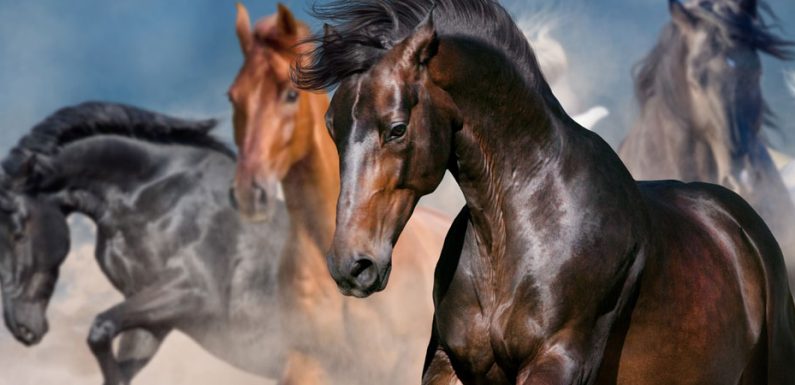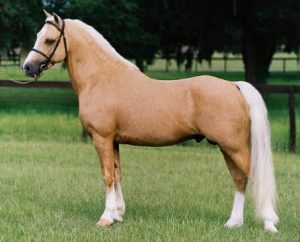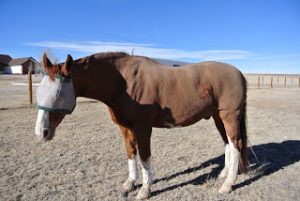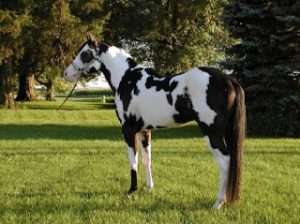

I’ve had quite a few horses in my life, but none had glamorous or flashy colours like a palomino, overo or silver dapple. No, it’s been bay, brown, chestnut and grey for me, and flea-bitten grey at that.
It’s not that I didn’t love the idea of having a horse with a beautiful and unusual coat colour, that’s just the way it panned out. Well, probably that and the fact that unusual coat colours are, by definition, less common.
This article describes how the chestnut, bay or brown, and black coat colours are controlled by two genes. To all the chestnut, bay and brown horses that I’ve loved – this is for you. Diablo, you gorgeous chunky flea-bitten grey, you’ll have your own article coming shortly.
The important things to remember when discussing genes are:
- Your horse has two copies of each gene*, one inherited from either parent;
- There are many different versions of each gene in the horse population, some of which can produce identical or nearly identical appearance and biological function, while other versions can produce a different coat colour or cause disease; and
- Each physical characteristic of your horse, including coat colour, results from the combined effects of the two copies of each gene, AND the interactions between a large number of different genes.

“What?” you say. “Didn’t you just say that the chestnut, bay or brown, and black coat colours are controlled by two genes? That’s not a large number.”
Well, I hope you said that! Clever clogs, I’d be thinking, because you’d be picking up an important point: there are a bunch of other genes where some uncommon versions of those genes can interact with black, bay or brown, and chestnut to make beautiful and unusual coat colours seen in horses that I’ve admired but never owned. But for most horses, the gene versions they’ve inherited are common ones that allow the basic black, bay or brown, and chestnut coat colours to shine through.
There will be more articles coming on this blog for overo, palomino and the other unusual horse coat colours.

Now, onwards to the gene that governs black vs. chestnut, and the other gene that restricts black to the points (you know, the legs, mane, tail, and ear edges).
The gene that governs black vs. chestnut is referred to as MC1R. This snappy little acronym is short for the melanocortin-1 receptor. Most versions of this gene allow the horse to produce black pigment that colours their hair (eumelanin, if you want to be technical). However, other versions of MC1R, which share a key mutation, cause a failure in the biological process that produces the black colour, leaving the horse with red pigment (pheomelanin) instead.
Your horse has two copies of this gene, one inherited from each parent. If your horse is chestnut, both of its parents passed on versions of the MC1R gene that make the red pigment.
If your horse has any black hairs (including the mane and tail), then at least one of its parents passed on a version of MC1R that allows it to produce the black pigment. But, just to be tricky, it’s impossible to tell just from looking whether your horse has inherited one vs. two black versions of the MC1R gene. Even when just one copy of the black version of the MC1R gene is present, it can do a very efficient job of making black pigment.
That’s one gene down – MC1R. Next up is the gene that restricts black pigment to the points. Its acronym is ASIP, short for agouti signalling peptide.
Basically, what most versions of the ASIP gene do is turn down or turn off black versions of the MC1R gene, resulting in red pigment being produced instead of black. But, these versions of the ASIP gene aren’t active everywhere: cells producing pigment for hair on the legs, ear margins, mane and tail continue to be able to produce black pigment.
Some versions of the ASIP gene don’t work properly, which means that they can’t turn off black versions of the MC1R gene. If your horse inherits these versions of the ASIP gene from both parents, and it is not a chestnut, it will be black. Mmmm, black.
But if your horse is chestnut, the versions of the ASIP gene it inherited from its dam and sire won’t change its colour – there is no black pigment production to turn down or turn off. That said, chestnuts dams and sires still pass on one of the versions of ASIP that they have themselves, which may affect the colour of their offspring.
Practical Horse Genetics can carry out genetic testing for chestnut, black and bay/brown.
* Except for genes on the X and Y chromosomes in male horses, where there may be only one copy.